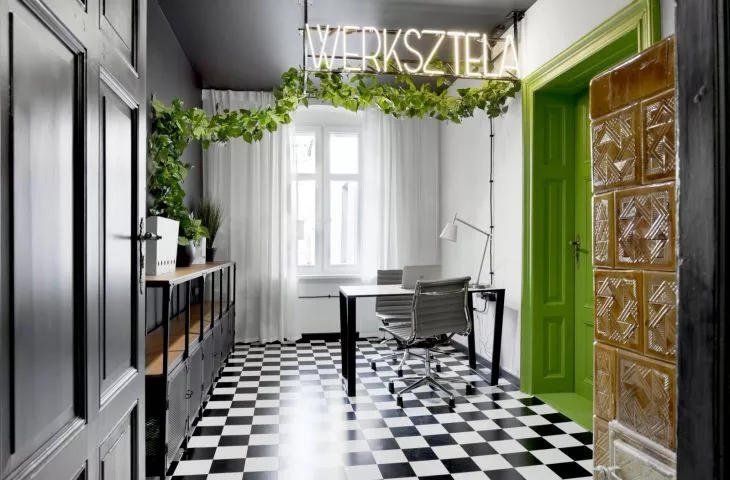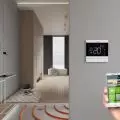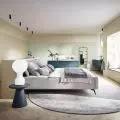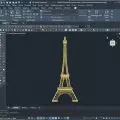A distinctive coworking office space has its place in one of Chorzow's townhouses. What makes it stand out is not only the catchy, humorous name, but also the interior, which combines the original elements of a typical Silesian apartment with modern design. The design studio Ola Jachymiak Studio, together with architect Anna Drozdowska, is responsible for this marriage of tradition and modernity.
DESKoteka, opened at the beginning of last year, is located on Wolności Street in Chorzów, one of the city's main arteries. It is a place that fits in with contemporary work trends - open to the needs of freelancers and freelancers or companies without permanent premises, and with a modern design. Ola Jachymiak and Anna Drozdowska, reorganizing the office space of about 75 meters, paid special attention to the existing elements of a typical Silesian apartment in the interior, i.e. the characteristic doors, the still functioning tiled stoves, which have been changed to electric ones, and the specific texture of the walls. It was these elements that became the inspiration for the design of a unique office with the atmosphere of a Silesian house, broken with industrial elements, associated with the character of the region. What had to be taken care of was not only the aesthetics of the interior, but also functionality, because the original room consisted of two passable office rooms and a conference room, but without a kitchen corner or a place for a printer. The designers decided to separate the necessary elements of the space from the long corridor, creating a coherent and functional whole.
The interior of DESKoteka in Chorzow
© Ola Jachymiak Studio
DESKoteka's office space in Chorzow
© Ola Jachymiak Studio
two aesthetic lines
After solving the issue of the space's layout, Jachymiak and Drozdowska were able to address their main design goal, which was to emphasize the elements found in the interior and make 100% use of them. The color scheme of the interior was inspired by two tiled stoves in brown and green, i.e. characteristic of the Silesia area, as seen in the region's contemporary architecture. "This is what Silesia is like: black under the ground, and green on the ground". - the designers stated. The interiors of the stoves were cleaned so they could operate efficiently, as were the doors, which were cleaned and painted black and green. The walls were also repainted, but retaining the distinctive paintable wallpaper covering them. The designers decided to put in an industrial surface-mounted installation as an additional interesting technical detail. In this way, the character of the Silesian tenement was emphasized, complemented by such elements as new flooring, steel legs and furniture or OSB countertops. The two aesthetic lines here - that of the Silesian house and that of the industrial city - form a coherent and attractive whole. As for the former, the details of a typically bourgeois interior are plants, curtains and stoves. On the other hand, we have elements typical of industrial architecture, i.e. steel, surface-mounted electrical installations, simple measures and simple colors, as well as a graphic line, represented, for example, by the black and white checkerboard floor. A major challenge, the designers emphasize, was to make a lamp in the conference room. Using ordinary bulb holders, they managed to create an industrial chandelier - a striking installation that gives a pleasant, two-stage light of warm color.
Green tiled stove and door in the DESKoteka office space in Chorzow.
© Ola Jachymiak Studio
The conference room of DESKothek in Chorzow
© Ola Jachymiak Studio
DESKoteka werkstel
Another Silesian accent that greets DESKothek guests at the very beginning at the reception desk is a neon sign that reads "Werksztela," which in Silesian dialect means "workplace/workshop." Further on, heading to the office space we find graphics by Yes O. Natalia Fudala and great posters by Ryszard Kai, thematically related to Silesia. These are very important elements that affect not only the aesthetics of the interior, but also support and promote domestic design at a high level. In particular, Kai's posters from the Poland series are in line with DESKoteka's aesthetic assumptions, as they refer to the tradition of the Polish poster school, while at the same time being a play on convention and the viewer. In addition, on one of the walls we also find a text written in the Silesian dialect and plaited in a simple font, beginning with the words: "Kaj te familoki...". Jachymiak and Drozdowska took care of every detail, creating a space that combines the best of both worlds, but also difficult to achieve: tradition and the present without falling into nostalgia.
DESKoteka kitchen corner in Chorzow
© Ola Jachymiak Studio






























